Michael Swanwick's Blog, page 100
March 31, 2017
Geek Highways: James Branch Cabell in Richmond-in-Virginia
.
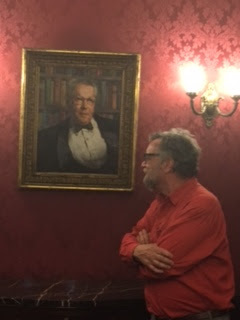
Richmond, Virginia is indelibly connected to Edgar Alan Poe, much to its civic disgust. Every building the man ever lived in there has been torn down and an attempt to have a statue raised in his honor was met with horror. There is a Poe Museum there, true, which I hope to return to someday (it has a pair of his socks!) but since I only had one day in town, I devoted it to Richmond's other great fantasist James Branch Cabell.
There I am with JBC's portrait in his library, which has been moved, books and furnishings and all, to the James Branch Cabell Library in Virginia Commonwealth University. This is a recursivity that would have amused Cabell greatly.
The day began with my visit (in pouring rain) to Hollywood Cemetery, a beautiful necropolis where Presidents Monroe and Tyler and Confederate President Davis are buried. Cabell is buried there alongside his son and both his wives. On the stone is a crest showing Kalki -- rampant in both senses -- with the slogan not MUNDIS VULT DECEPI, which is recurrent in his work and means THE WORLD WISHES TO BE DECEIVED but IMPAVIDE, which means FEARLESSNESS.
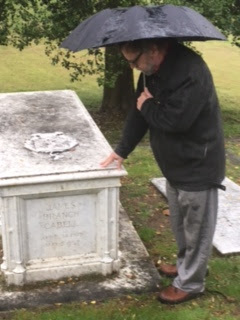
After which, Marianne ran over to the main branch of the Richmond Public Library, which is located on the site of the long-vanished building where Cabell was born.

Finally, it was off to the Special Collections and Archives in the JBC Library at VCU, there to inspect four letters that Alistair Crowley wrote to Cabell and some interesting conversation with the curator of the Cabell papers, Ron Bonis, a man who knows considerably more about Cabell than I ever did. Which is something I have to respect.
The picture below should give you a good idea of the comfortable opulence of the room. I examined Cabell's collection of books and have to say it's quite nice. I could happily spend a week there, browsing. I had to admire his collection of occult and folklore and related books in particular.

There's so much more I could say about Cabell. I could write a book about the man and his work, and in fact I have: What Can Be Saved From the Wreckage: James Branch Cabell in the Twenty-First Century (preface by Barry Humphry, no longer available from Temporary Culture, though the ebook of it is). But this is running long as it is. So, instead, I'll give you a small notion of just what a big noise Cabell used to be: Below is a bust of one of his creations, Aesred, the plump and slightly sullen Goddess of Compromise. The sculptor Edward R. Amateis crafted it from a block of marble imported from Greece to Rome in the first century C. E. and then gave it to him as a gift.
That's how big a noise James Branch Cabell once was. He was the single most successful living fantasist of the Twentieth Century. (Tolkien surpassed him, but onlyposthumously.)

And because life goes on...
I have been received the following news from Open Road Media, my ebook publisher,:
I’m pleased to let you know that Bones of the Earth will be featured in BookBub International, an ebook deals newsletter with subscribers in Canada, Australia, and the United Kingdom, on 4/1/2017. The ebook will be downpriced to the equivalent of 1.99 in Canada on that day, and Open Road will promote the feature via social media.
So if you're Canadian, read ebooks, and like science fiction with lots and lots of dinosars this is your opportunity. If you're Canadian and don't read ebooks, that's fine too. But if you're Canadian and don't like science fiction with lots and lots of dinsosaurs, Rob Sawyer has a few firm words to share with you.
*

Richmond, Virginia is indelibly connected to Edgar Alan Poe, much to its civic disgust. Every building the man ever lived in there has been torn down and an attempt to have a statue raised in his honor was met with horror. There is a Poe Museum there, true, which I hope to return to someday (it has a pair of his socks!) but since I only had one day in town, I devoted it to Richmond's other great fantasist James Branch Cabell.
There I am with JBC's portrait in his library, which has been moved, books and furnishings and all, to the James Branch Cabell Library in Virginia Commonwealth University. This is a recursivity that would have amused Cabell greatly.
The day began with my visit (in pouring rain) to Hollywood Cemetery, a beautiful necropolis where Presidents Monroe and Tyler and Confederate President Davis are buried. Cabell is buried there alongside his son and both his wives. On the stone is a crest showing Kalki -- rampant in both senses -- with the slogan not MUNDIS VULT DECEPI, which is recurrent in his work and means THE WORLD WISHES TO BE DECEIVED but IMPAVIDE, which means FEARLESSNESS.

After which, Marianne ran over to the main branch of the Richmond Public Library, which is located on the site of the long-vanished building where Cabell was born.

Finally, it was off to the Special Collections and Archives in the JBC Library at VCU, there to inspect four letters that Alistair Crowley wrote to Cabell and some interesting conversation with the curator of the Cabell papers, Ron Bonis, a man who knows considerably more about Cabell than I ever did. Which is something I have to respect.
The picture below should give you a good idea of the comfortable opulence of the room. I examined Cabell's collection of books and have to say it's quite nice. I could happily spend a week there, browsing. I had to admire his collection of occult and folklore and related books in particular.

There's so much more I could say about Cabell. I could write a book about the man and his work, and in fact I have: What Can Be Saved From the Wreckage: James Branch Cabell in the Twenty-First Century (preface by Barry Humphry, no longer available from Temporary Culture, though the ebook of it is). But this is running long as it is. So, instead, I'll give you a small notion of just what a big noise Cabell used to be: Below is a bust of one of his creations, Aesred, the plump and slightly sullen Goddess of Compromise. The sculptor Edward R. Amateis crafted it from a block of marble imported from Greece to Rome in the first century C. E. and then gave it to him as a gift.
That's how big a noise James Branch Cabell once was. He was the single most successful living fantasist of the Twentieth Century. (Tolkien surpassed him, but onlyposthumously.)

And because life goes on...
I have been received the following news from Open Road Media, my ebook publisher,:
I’m pleased to let you know that Bones of the Earth will be featured in BookBub International, an ebook deals newsletter with subscribers in Canada, Australia, and the United Kingdom, on 4/1/2017. The ebook will be downpriced to the equivalent of 1.99 in Canada on that day, and Open Road will promote the feature via social media.
So if you're Canadian, read ebooks, and like science fiction with lots and lots of dinosars this is your opportunity. If you're Canadian and don't read ebooks, that's fine too. But if you're Canadian and don't like science fiction with lots and lots of dinsosaurs, Rob Sawyer has a few firm words to share with you.
*
Published on March 31, 2017 13:58
Geek Highways: Digger's Dungeon
.
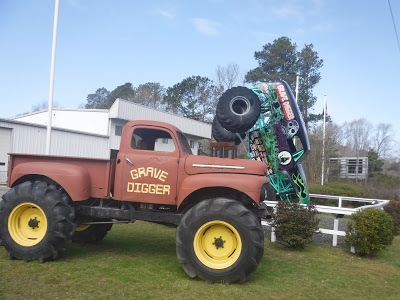
(This post should properly have been made yesterday. Mea culpa. I only just now found an online editing tool to make the photo fit for Blogger.)
Unless you're already a fan, this takes a bit of explanation. Dennis Anderson is famous in monster truck circuits for his series of Grave Digger trucks.There's the original to the fore. It was a mud bogger until a monster truck failed to make an appearance at a show and he volunteered to crush cars with his own truck. That sold him.
Over the decades, the Grave Diggers (there have been dozens of them) got bigger,more powerful,and more thoroughly spray-painted with skulls, ghouls, and similarly Halloweeny blue-collar art. And of course, they aged out.
So long as the teams (I think there are nine of them now, making the circuits) needed a place to store and restore trucks not in use, somebody decided to take some of the old truck bodies and make a roadside attraction out of them. Hence, Digger's Dungeon. Trucks, a bit of welder's art, an enclosure with a goat, a pig, and various poultry, strange stuff, and a gift shop where you can buy an action figure of Dennis Anderson.
Anderson had to retire recently, after a failed flip resulted in unspecified injuries. I hope they were minor and he'll make a full recovery. A man who has devoted his life to giving people joy (and, boy howdy, monster trucks do!) deserves nothing less.
You can find Digger's Dungeon in Poplar Branch, North Carolina. In fact, if you're driving through you can't possibly miss it.
*

(This post should properly have been made yesterday. Mea culpa. I only just now found an online editing tool to make the photo fit for Blogger.)
Unless you're already a fan, this takes a bit of explanation. Dennis Anderson is famous in monster truck circuits for his series of Grave Digger trucks.There's the original to the fore. It was a mud bogger until a monster truck failed to make an appearance at a show and he volunteered to crush cars with his own truck. That sold him.
Over the decades, the Grave Diggers (there have been dozens of them) got bigger,more powerful,and more thoroughly spray-painted with skulls, ghouls, and similarly Halloweeny blue-collar art. And of course, they aged out.
So long as the teams (I think there are nine of them now, making the circuits) needed a place to store and restore trucks not in use, somebody decided to take some of the old truck bodies and make a roadside attraction out of them. Hence, Digger's Dungeon. Trucks, a bit of welder's art, an enclosure with a goat, a pig, and various poultry, strange stuff, and a gift shop where you can buy an action figure of Dennis Anderson.
Anderson had to retire recently, after a failed flip resulted in unspecified injuries. I hope they were minor and he'll make a full recovery. A man who has devoted his life to giving people joy (and, boy howdy, monster trucks do!) deserves nothing less.
You can find Digger's Dungeon in Poplar Branch, North Carolina. In fact, if you're driving through you can't possibly miss it.
*
Published on March 31, 2017 05:04
Geek Highways: "Yellowjack" Walter Reed's Birthplace
.
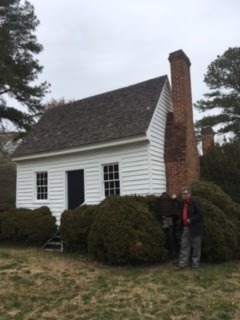
Down a quiet road in a remote part of Gloucester County, Virginia, is the tiny house that was the birthplace of Walter Reed. Reed was the Army doctor who led the team that established that "Yellowjack" -- Yellow Fever -- was spread not by contact but by mosquito bites. This and other discoveries make him one of the fathers of epidemiology.
There I am, yesterday, in front of the house. Really, it should have been Marianne since so much of her work involved epidemiology. But life isn't always fair. Dr. Reed always credited Cuban doctor Carlos Finlay for discovering the disease vector and how to control it. Alas, we have only room in our memories for one name when crediting such things.
But, as either doctor would have told you, credit is a minor thing. What most matters is the number of lives saved, the sheer mass of human misery prevented.
For which we can thank those two men and all those who worked with them.
And, remarkably enough....
Remember Ardudwy, Will Jenkins'/Murray Leinster's house, which I blogged about yesterday? It's maybe two miles, certainly no more, from the Walter Reed birthplace. There are hidden patterns everywhere.
*

Down a quiet road in a remote part of Gloucester County, Virginia, is the tiny house that was the birthplace of Walter Reed. Reed was the Army doctor who led the team that established that "Yellowjack" -- Yellow Fever -- was spread not by contact but by mosquito bites. This and other discoveries make him one of the fathers of epidemiology.
There I am, yesterday, in front of the house. Really, it should have been Marianne since so much of her work involved epidemiology. But life isn't always fair. Dr. Reed always credited Cuban doctor Carlos Finlay for discovering the disease vector and how to control it. Alas, we have only room in our memories for one name when crediting such things.
But, as either doctor would have told you, credit is a minor thing. What most matters is the number of lives saved, the sheer mass of human misery prevented.
For which we can thank those two men and all those who worked with them.
And, remarkably enough....
Remember Ardudwy, Will Jenkins'/Murray Leinster's house, which I blogged about yesterday? It's maybe two miles, certainly no more, from the Walter Reed birthplace. There are hidden patterns everywhere.
*
Published on March 31, 2017 00:30
March 30, 2017
Geek Highways: Ardudwy
.
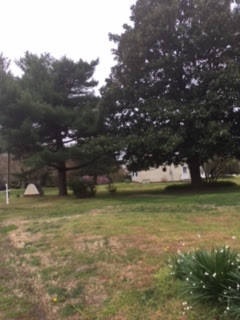
(I've got far better photos on my camera. But none of the machines I brought with me appear to be capable of resizing them for Blogger. So: My apologies. I'll replace the photo with a much better one and delete this opening when I get home.)
On the bank of the York River, in a still-remote part of Gloucester County, Virginia, that was a heaven for his small daughters, sits Murray Leinster's house, Ardudwy. that's it up above.
Will F. Jenkins was a very successful fiction writer whose love of science led him to write science fiction, against his agent's horrified objections, under the Murray Leinster pseudonym. He was the single most important SF writer between H. G. Wells and Robert Heinlein. At a time when the stuff was mostly written by untalented hacks and paid accordingly, he wrote the kind of exciting idea-fiction that lit a fire in the young brains of Isaac Asimov and many, many other writers-to-be. He wrote the first "first contact" story. In "The Runaway Skyscraper," he invented alternate history. In "A Logic Named Joe," he describe the Internet in detail -- in 1946! He was the first Dean of Science Fiction.
And I met him.
I did! When I was 29, Dr. David Clay Jenkins (no relation), the single most valuable teacher I ever had at William & Mary (and there were many to whom I owe enormous gratitude) took me and my friend Paul Fuchs to meet the great man. I wrote a sketchy account of it here. Short version: He dazzled. He was everything a writer should be: Lordly, gracious, interested in everything, full of lore, bubbling with ideas, enthusiastic about great writing, in love with language, an amateur inventor. And kind to at least one young fool.
*

(I've got far better photos on my camera. But none of the machines I brought with me appear to be capable of resizing them for Blogger. So: My apologies. I'll replace the photo with a much better one and delete this opening when I get home.)
On the bank of the York River, in a still-remote part of Gloucester County, Virginia, that was a heaven for his small daughters, sits Murray Leinster's house, Ardudwy. that's it up above.
Will F. Jenkins was a very successful fiction writer whose love of science led him to write science fiction, against his agent's horrified objections, under the Murray Leinster pseudonym. He was the single most important SF writer between H. G. Wells and Robert Heinlein. At a time when the stuff was mostly written by untalented hacks and paid accordingly, he wrote the kind of exciting idea-fiction that lit a fire in the young brains of Isaac Asimov and many, many other writers-to-be. He wrote the first "first contact" story. In "The Runaway Skyscraper," he invented alternate history. In "A Logic Named Joe," he describe the Internet in detail -- in 1946! He was the first Dean of Science Fiction.
And I met him.
I did! When I was 29, Dr. David Clay Jenkins (no relation), the single most valuable teacher I ever had at William & Mary (and there were many to whom I owe enormous gratitude) took me and my friend Paul Fuchs to meet the great man. I wrote a sketchy account of it here. Short version: He dazzled. He was everything a writer should be: Lordly, gracious, interested in everything, full of lore, bubbling with ideas, enthusiastic about great writing, in love with language, an amateur inventor. And kind to at least one young fool.
*
Published on March 30, 2017 18:01
Geek Highways: The Roanoke Colony
.
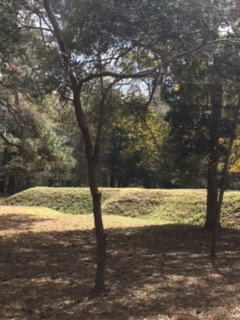
Yesterday, Marianne and I went to Roanoke Island, site of the lost Roanoke Colony, the earliest and most enduring mystery of post-Columbian America.
In slapdash short: Sir Walter Raleigh (not in person; Queen Elizabeth wouldn't let him go adventuring in the New World) planted a small colony in what would later be North Carolina. If it succeeded, it would make a swell port which British privateers could raid the Spanish treasure ships. He also had dreams of peacefully colonizing North America by making the American chieftains British lords and their people citizens. The colony, however, was underprovisioned and sent their governor back for more supplies.
Enter the Spanish Armada. It was three years before John White (Virginia Dare's grandfather) was able to acquire a boat (all had been essentially nationalized to fight off the threat) and funding to return. Only to find that the colonists had taken up their weapons and essentials and left. In their absence, the buildings had been torn down and chests they had buried containing possessions they could not take with them had been dug up and their contents scattered about. The word CROATOAN carved into a tree suggested that they had gone to live with friendly Indians at Croatoan. White wanted to go look for them, but a storm came up so they went back to England instead.
Yeah, that last bit makes no sense to me either. In fiction, it would a clue. But maybe things will be clearer to me after I read a book or three.
We visited the site. A great deal has been added and nothing remains. There's an open-air amphitheater with the ocean behind the stage and the wind singing through the light scaffolding. There's a large fantasy of what an Elizabethan garden might have been like with proper funding and Twentieth-Century sensibilities created by the local garden club. There's a slope-shouldered recreation of the small dirt fort that had been built there, based on archaeological measurements.
Of the original colony, there is not a trace. Nothing remains behind but silence. And mystery.
Next up: Monster Trucks!
*

Yesterday, Marianne and I went to Roanoke Island, site of the lost Roanoke Colony, the earliest and most enduring mystery of post-Columbian America.
In slapdash short: Sir Walter Raleigh (not in person; Queen Elizabeth wouldn't let him go adventuring in the New World) planted a small colony in what would later be North Carolina. If it succeeded, it would make a swell port which British privateers could raid the Spanish treasure ships. He also had dreams of peacefully colonizing North America by making the American chieftains British lords and their people citizens. The colony, however, was underprovisioned and sent their governor back for more supplies.
Enter the Spanish Armada. It was three years before John White (Virginia Dare's grandfather) was able to acquire a boat (all had been essentially nationalized to fight off the threat) and funding to return. Only to find that the colonists had taken up their weapons and essentials and left. In their absence, the buildings had been torn down and chests they had buried containing possessions they could not take with them had been dug up and their contents scattered about. The word CROATOAN carved into a tree suggested that they had gone to live with friendly Indians at Croatoan. White wanted to go look for them, but a storm came up so they went back to England instead.
Yeah, that last bit makes no sense to me either. In fiction, it would a clue. But maybe things will be clearer to me after I read a book or three.
We visited the site. A great deal has been added and nothing remains. There's an open-air amphitheater with the ocean behind the stage and the wind singing through the light scaffolding. There's a large fantasy of what an Elizabethan garden might have been like with proper funding and Twentieth-Century sensibilities created by the local garden club. There's a slope-shouldered recreation of the small dirt fort that had been built there, based on archaeological measurements.
Of the original colony, there is not a trace. Nothing remains behind but silence. And mystery.
Next up: Monster Trucks!
*
Published on March 30, 2017 06:13
March 29, 2017
Geek Highways: Kitty Hawk
.
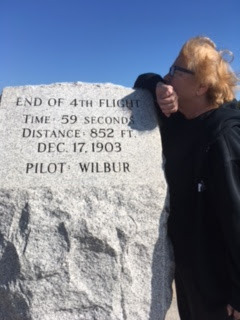
Okay, yes, Wilbur and Orville Wright made their first flights from Kill Devil Hills, not Kitty Hawk and Kitty Hawk only got the credit because that's where the telegraph station was from which they sent the news.
That's just the fine print. It doesn't really matter.
What matters is that in what was then was a lonely, isolated corner of North Carolina, the Wright Brothers made their first four flights on December 17, 1903. Since then, the sand dune looming over the site has been stabilized and turned into a grassy hill, atop which is a huge memorial. A small airstrip has been added. A life sized installation of statues representing the brothers, their flyers, and everyone present at the first flight has been thrown into the mix. And the usual tourist center has been erected as well.
All very nice. But what's moving is to go to the boulder marking the place where the flyer took to the air and pace out the distance to stones marking where it came down for the first three flights -- hops, really, up in the air for a few seconds -- and then far beyond them to the end of the first sustained powered manned heavier-than-air flight of 852 feet in 59 seconds.
The moment that flight had been achieved, Boeing 747s became inevitable.
It's quiet at the memorial site and there's a steady wind from the sea. It's a good place to reflect how little time separates those two uncommon men from us.
Above: Marianne at the fourth touchdown stone.
*

Okay, yes, Wilbur and Orville Wright made their first flights from Kill Devil Hills, not Kitty Hawk and Kitty Hawk only got the credit because that's where the telegraph station was from which they sent the news.
That's just the fine print. It doesn't really matter.
What matters is that in what was then was a lonely, isolated corner of North Carolina, the Wright Brothers made their first four flights on December 17, 1903. Since then, the sand dune looming over the site has been stabilized and turned into a grassy hill, atop which is a huge memorial. A small airstrip has been added. A life sized installation of statues representing the brothers, their flyers, and everyone present at the first flight has been thrown into the mix. And the usual tourist center has been erected as well.
All very nice. But what's moving is to go to the boulder marking the place where the flyer took to the air and pace out the distance to stones marking where it came down for the first three flights -- hops, really, up in the air for a few seconds -- and then far beyond them to the end of the first sustained powered manned heavier-than-air flight of 852 feet in 59 seconds.
The moment that flight had been achieved, Boeing 747s became inevitable.
It's quiet at the memorial site and there's a steady wind from the sea. It's a good place to reflect how little time separates those two uncommon men from us.
Above: Marianne at the fourth touchdown stone.
*
Published on March 29, 2017 18:04
March 28, 2017
Geek Highways: Wallops Island
.
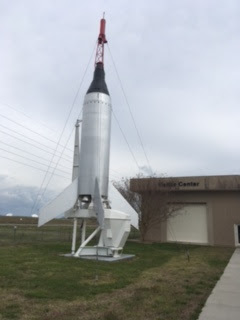
Officially, it's called the Wallops Flight Facility but I've never heard anyone call it anything but Wallops Island. It's not like there's a lot of anything else there.
Wallops Island is one of five main flight facilities operated by NASA and, let's be honest, isn't a patch on Canaveral. It's responsible for twenty to thirty sounding rockets a year, only four or five of which are launched locally. The rest are launched from sites around the world as needed. The Mid-Atlantic Regional Spaceport, which it operates, is probably best known today for the private-industry Antares rockets launched there by Orbital ATK.
Marianne and I stopped here on our way to Kitty Hawk, tracing in reverse a voyage that went from a 59-second flight to the Moon over the space of a single human lifetime. It didn't matter that Wallops Island has only two launch pads. Standing by the road, looking at the parabolic antennas aimed at the heavens, I felt like I was standing on the shores of space.
As of course I was.
As of course, so are we all.
Above: "Little Joe," used to test the Mercury capsule, its emergency escape systems in particular.
*

Officially, it's called the Wallops Flight Facility but I've never heard anyone call it anything but Wallops Island. It's not like there's a lot of anything else there.
Wallops Island is one of five main flight facilities operated by NASA and, let's be honest, isn't a patch on Canaveral. It's responsible for twenty to thirty sounding rockets a year, only four or five of which are launched locally. The rest are launched from sites around the world as needed. The Mid-Atlantic Regional Spaceport, which it operates, is probably best known today for the private-industry Antares rockets launched there by Orbital ATK.
Marianne and I stopped here on our way to Kitty Hawk, tracing in reverse a voyage that went from a 59-second flight to the Moon over the space of a single human lifetime. It didn't matter that Wallops Island has only two launch pads. Standing by the road, looking at the parabolic antennas aimed at the heavens, I felt like I was standing on the shores of space.
As of course I was.
As of course, so are we all.
Above: "Little Joe," used to test the Mercury capsule, its emergency escape systems in particular.
*
Published on March 28, 2017 16:26
March 27, 2017
Geek Highways: Bottle Trees.
.

I spent the day wandering about marshlands, doing research for The Iron Dragon's Mother . Lots of nifty stuff: wild ponies seen from a distance, a gannet seen from three feet away and so on. But, necessary though all this was, none of it was geeky.
So today's blog is about a chance sighting of a cluster of bottle trees as Marianne and I passed through Stockton, Maryland yesterday.
A bottle tree is simply a dead tree whose branches have been cut short and then adorned with a glass bottle. Scholars have traced the practice back to Africa, where the practice had a religious significance. It survived American slavery and, although for a time looked to be on its way to extinction. Instead, it spread through the South to such a degree that a certain number of whites make them too.
So why do they exist today? For the same reason that Morris dancing and Krampus exist today -- not because we necessarily agree with or even know their original purpose, but because they're fun. Because they're real. Because they satisfy something deep within the human spirit.
I look for stuff like this everywhere I go. I like to think of it as Evidence of Intelligent Life on Earth.
You can read a Smithsonian article about bottle trees here.

*

I spent the day wandering about marshlands, doing research for The Iron Dragon's Mother . Lots of nifty stuff: wild ponies seen from a distance, a gannet seen from three feet away and so on. But, necessary though all this was, none of it was geeky.
So today's blog is about a chance sighting of a cluster of bottle trees as Marianne and I passed through Stockton, Maryland yesterday.
A bottle tree is simply a dead tree whose branches have been cut short and then adorned with a glass bottle. Scholars have traced the practice back to Africa, where the practice had a religious significance. It survived American slavery and, although for a time looked to be on its way to extinction. Instead, it spread through the South to such a degree that a certain number of whites make them too.
So why do they exist today? For the same reason that Morris dancing and Krampus exist today -- not because we necessarily agree with or even know their original purpose, but because they're fun. Because they're real. Because they satisfy something deep within the human spirit.
I look for stuff like this everywhere I go. I like to think of it as Evidence of Intelligent Life on Earth.
You can read a Smithsonian article about bottle trees here.

*
Published on March 27, 2017 18:41
March 26, 2017
Geek Highways: Wallops Island
.
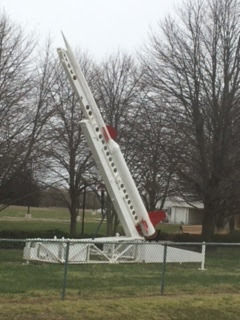
As always, I'm on the road again -- this time, making a pilgrimage to Kitty Hawk, where human heavier-than-air flight had its humble beginning.
A long drive through grey and brown countryside brought Marianne and me to Wallops Island, site of one of NASA's five main launch facilities. It's humbling to stand here, on the shores of space at the slender instant in time during which life leaves the planet.
When I was born, most people would have told you flat-out that human beings would ever walk on the Moon. Yet it happened only sixty-six years after that first fifty-nine second flight that it happened. That's roughly one human lifespan!
Long after Apollo 11, people commonly said that a computer would never beat a human grand master at chess. Then, in 1997, Deep Blue beat Gary Kasparov in a six-game match 3 1/2 to 2 1/2. So, as people will, the doubters redrew the goal lines and said that a computer would never beat a human go master.
On March 15, last year, AlphaGo defeated Lee Sedol in the last game of a five-game match. Final score: AlphaGo 4, Lee Sedol 1.
Something to keep in mind next time somebody tells you we'll never have a true AI or a colony on an extrasolar planet.
Above: One of the rockets outside the Wallops Flight Facility. I probably had the plastic model back when I was a teen.
*

As always, I'm on the road again -- this time, making a pilgrimage to Kitty Hawk, where human heavier-than-air flight had its humble beginning.
A long drive through grey and brown countryside brought Marianne and me to Wallops Island, site of one of NASA's five main launch facilities. It's humbling to stand here, on the shores of space at the slender instant in time during which life leaves the planet.
When I was born, most people would have told you flat-out that human beings would ever walk on the Moon. Yet it happened only sixty-six years after that first fifty-nine second flight that it happened. That's roughly one human lifespan!
Long after Apollo 11, people commonly said that a computer would never beat a human grand master at chess. Then, in 1997, Deep Blue beat Gary Kasparov in a six-game match 3 1/2 to 2 1/2. So, as people will, the doubters redrew the goal lines and said that a computer would never beat a human go master.
On March 15, last year, AlphaGo defeated Lee Sedol in the last game of a five-game match. Final score: AlphaGo 4, Lee Sedol 1.
Something to keep in mind next time somebody tells you we'll never have a true AI or a colony on an extrasolar planet.
Above: One of the rockets outside the Wallops Flight Facility. I probably had the plastic model back when I was a teen.
*
Published on March 26, 2017 19:50
March 24, 2017
Geek Highways II
.

As always, I'm on the road again. Or, rather, I will be soon. Sunday, Marianne and I had out for our second Geek Highways tour, a trek from Philadelphia to Wallops Island and then Kitty Hawk, with (I hope) strange stops in between.
I'll be blogging every day, which should make a welcome change from the neglect I've been showering on the blog of late.
(For which, again, my apologies. I've been dream-deep in The Iron Dragon's Mother and it's taken me away from many a lesser effort. Luckily, the final sections take place on the seacoast of Faerie so I need lots of material on coastlands and marshlands. Which is, to be honest, the secret motivation behind this adventure.)
So, starting rather late Sunday, expect to see more science-and-literature adventures here. It'll be fun!
Above: From the original Geek Highways, three years ago, the historic Gardner Dozois house, home of the young writer-and-editor-to-be.
*

As always, I'm on the road again. Or, rather, I will be soon. Sunday, Marianne and I had out for our second Geek Highways tour, a trek from Philadelphia to Wallops Island and then Kitty Hawk, with (I hope) strange stops in between.
I'll be blogging every day, which should make a welcome change from the neglect I've been showering on the blog of late.
(For which, again, my apologies. I've been dream-deep in The Iron Dragon's Mother and it's taken me away from many a lesser effort. Luckily, the final sections take place on the seacoast of Faerie so I need lots of material on coastlands and marshlands. Which is, to be honest, the secret motivation behind this adventure.)
So, starting rather late Sunday, expect to see more science-and-literature adventures here. It'll be fun!
Above: From the original Geek Highways, three years ago, the historic Gardner Dozois house, home of the young writer-and-editor-to-be.
*
Published on March 24, 2017 09:20
Michael Swanwick's Blog
- Michael Swanwick's profile
- 546 followers
Michael Swanwick isn't a Goodreads Author
(yet),
but they
do have a blog,
so here are some recent posts imported from
their feed.



